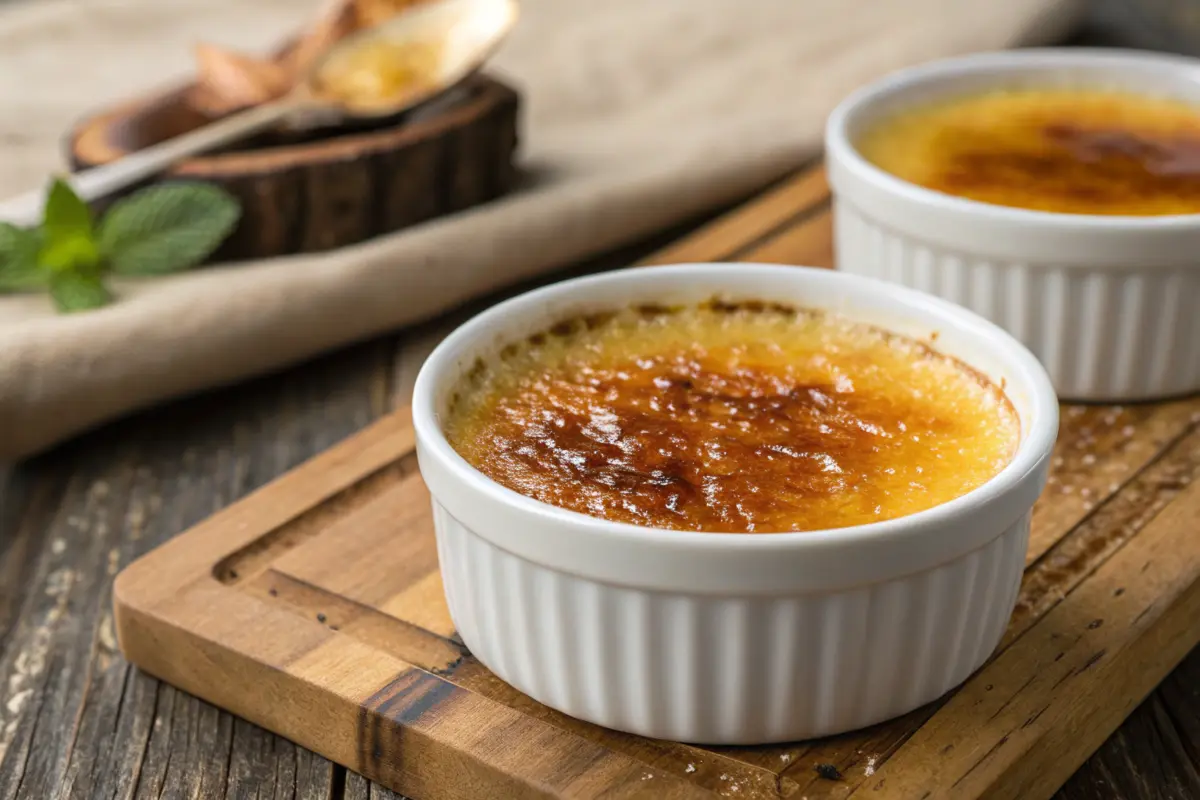Ever wondered about the magic behind a truly exceptional crème brûlée? It’s that delightful crack of the caramelized sugar, followed by the smooth, creamy custard beneath, isn’t it? This article will take you on a journey to uncover what is the secret to crème brûlée, exploring all the crème brûlée secrets needed to master this dessert. We’re demystifying this classic treat and equipping you with the knowledge to create it perfectly every time. We’ll delve into the science behind the custard, explore effective crème brûlée techniques, and reveal how to make perfect crème brûlée. So, if you’re ready to unlock the secrets and learn the best creme brulee recipe for yourself, let’s get started!
Introduction to the Allure of Crème Brûlée
Unveiling the Magic: The Allure of Crème Brûlée
There’s something undeniably captivating about crème brûlée. It’s more than just a dessert; it’s an experience that engages all your senses. From the visual appeal of that glossy, caramelized top to the satisfying crack as you break through it, the rich vanilla aroma, and the velvety smooth custard, everything about it screams elegance. It’s a classic for a reason. But what is the secret to crème brûlée that makes it so irresistible, and how do we truly unlock crème brûlée secrets? Perhaps one of the crème brûlée secrets lies in the delicate balance between the crisp and creamy textures, the sophisticated yet simple flavors, and the way it always feels like a treat. Many wonder how to make perfect crème brûlée, but it’s the specific combination that makes it magical. Understanding what is the secret to crème brûlée is key.
What is Crème Brûlée and Why is it So Beloved?
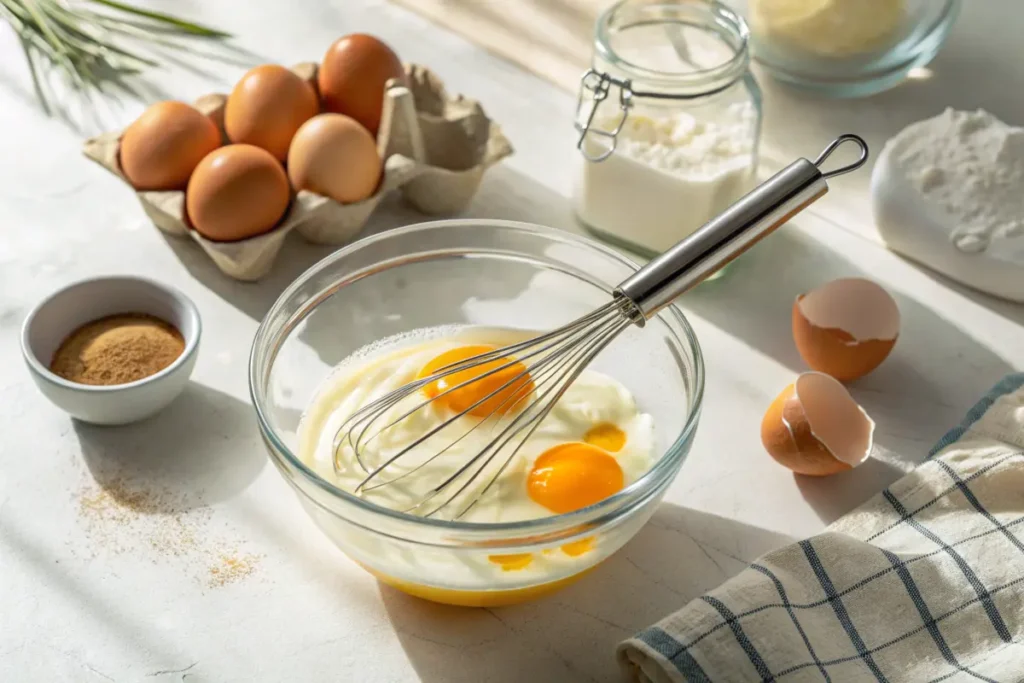
Crème brûlée is a custard base baked to perfection, topped with caramelized sugar. This simple description misses the magic. Understanding what is the secret to crème brûlée means more than listing ingredients. Served in ramekins, the vanilla custard is rich and smooth thanks to egg yolks and heavy cream. It’s creamy, buttery, and irresistible – a key to achieving perfect crème brûlée. The torched or broiled top creates the unique contrast. It’s beloved because it’s a study in contrasts, and how to make perfect crème brûlée depends on mastering the technique and scien
The Quest for Perfect Crème Brûlée
Crème brûlée is a custard baked to perfection, topped with caramelized sugar. This description misses the magic; what is the secret to crème brûlée is more than that. Served in ramekins, the vanilla custard is rich and smooth due to egg yolks and heavy cream. It’s creamy, buttery, and a key part of achieving perfect crème brûlée. The torched or broiled top creates the contrast. It’s beloved for these elements, and how to make perfect crème brûlée relies on mastering technique and science. Even with experience, things can go wrong – custard can curdle, be runny, or the caramelization uneven. This raises the question: what is the secret to crème brûlée? This article will provide crème brûlée tips and techniques to achieve it consistently.
The Science Behind the Custard
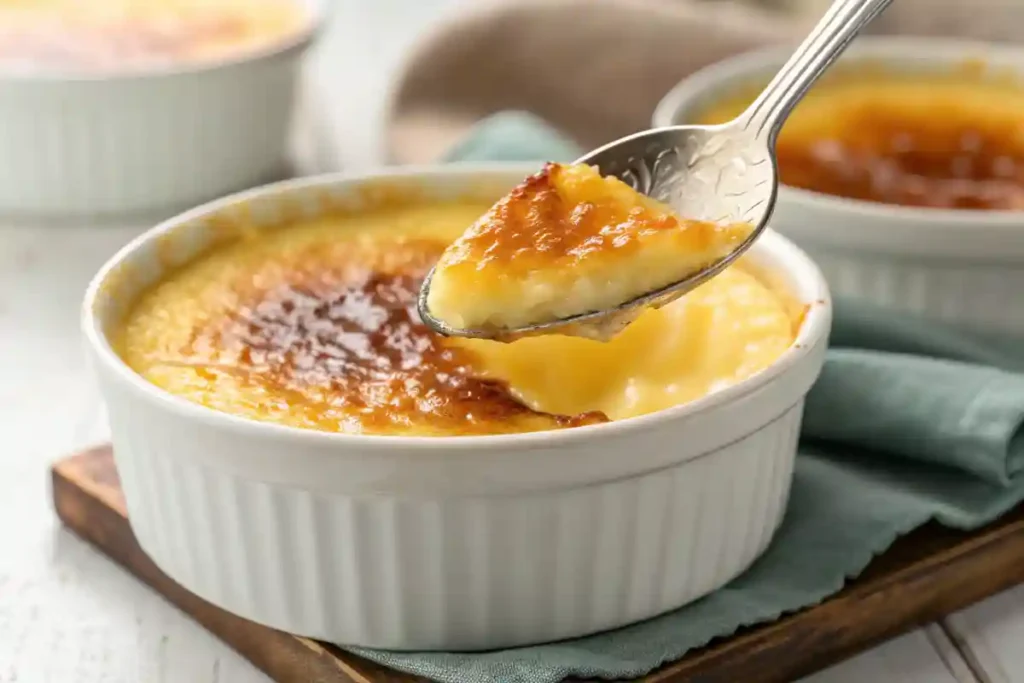
Understanding the Fundamentals: The Science of Crème Brûlée
Before we delve into the techniques, let’s explore the science behind making a great crème brûlée. Understanding what happens at a molecular level will help you grasp what is the secret to crème brûlée, and why each step is essential. It’s fascinating how simple ingredients, when combined with care, create such complex flavors and textures. Let’s explore the chemistry that makes crème brûlée so magical, because knowing the science is vital to understanding how to make perfect crème brûlée. Unlocking the crème brûlée secrets requires a scientific approach to the process.
The Role of Egg Yolks in a Crème Brûlée
At the heart of every creamy custard are egg yolks. In crème brûlée, egg yolks aren’t just for color; they’re the key structural component. Packed with proteins, they undergo protein coagulation when heated, forming the gel that sets the custard. The richness and smoothness of crème brûlée depend on the fat content of the egg yolks, so fresh ones are key for a silky outcome. If you’re wondering what is the secret to crème brûlée, understanding the importance of fresh egg yolks is crucial. Don’t skimp on egg quality if you want the best creme brulee recipe.
The Importance of Heavy Cream
While egg yolks provide the structure, heavy cream creates the luxuriously smooth and creamy texture we expect in crème brûlée. Using heavy cream, with its high fat content, is one of the crème brûlée secrets that gives it that buttery richness and velvety feel. The fat keeps the custard moist, preventing it from becoming dense. The higher the fat, the richer the custard. Therefore, using heavy cream, not milk, is essential for achieving perfect crème brûlée. It’s what gives it that luxurious mouthfeel, and this is vital in understanding what is the secret to crème brûlée. For the best creme brulee recipe, heavy cream is a must.
The impact of Sugar in the Custard
Sugar plays a vital, often overlooked, role in the custard itself. While it adds sweetness, it’s also key to the texture. Sugar interacts with the egg yolk proteins, creating a more tender custard and stabilizing it during baking. Using the right amount of sugar is critical; too much can make the custard dense, too little can make it too firm. The trick is finding the balance. The correct amount of sugar enhances flavor and is essential for the texture of this special dessert. This balance is indeed, a key part of crème brûlée secrets, and vital for achieving perfect crème brûlée. If you want to understand what is the secret to crème brûlée, remember the importance of sugar in the custard base.
The Art of Caramelization
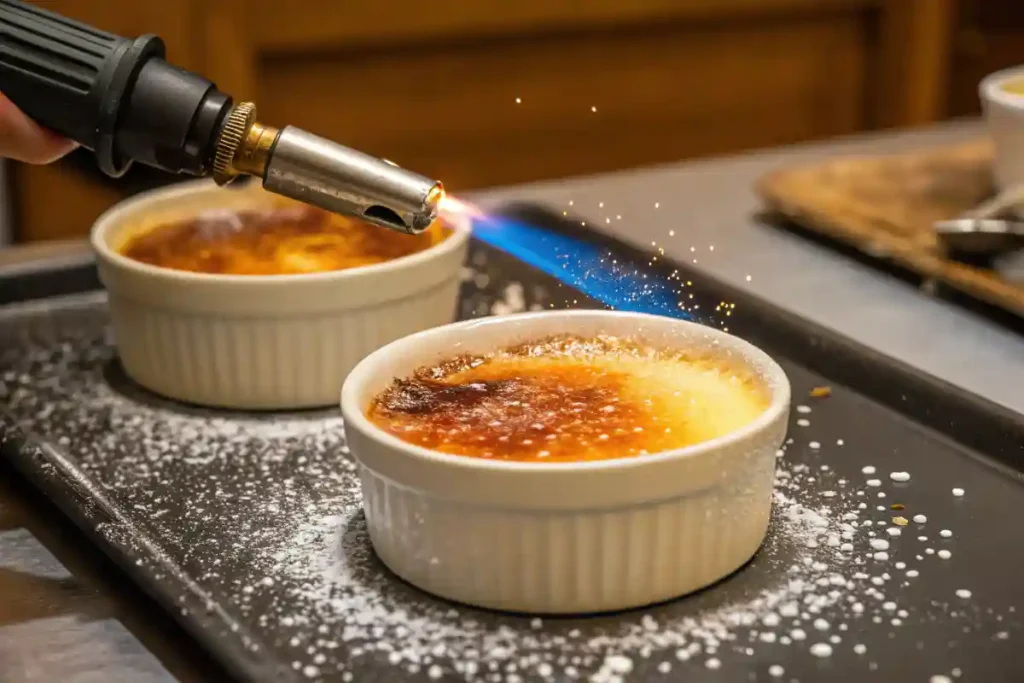
The Golden Top: Mastering Caramelization for Crème Brûlée
The hallmark of crème brûlée, undoubtedly, is its golden, crisp top. This isn’t just for looks; the textural and flavor contrast between the caramelized sugar and the creamy custard makes this dessert captivating. The caramelization process is a precise chemical reaction requiring knowledge of sugar. Mastering this is essential to achieving perfect crème brûlée and for creating a stunning result. Understanding what is the secret to crème brûlée includes knowing how caramelization works. For the best creme brulee recipe, that caramel topping is key, making mastering caramelization a vital crème brûlée technique.
The Science of Sugar Caramelization
Sugar caramelization isn’t just melting sugar; it’s a complex chemical breakdown of sugar molecules using heat. When heated, sugar goes through reactions from melting to decomposition. This creates compounds that give caramel its unique flavor, color, and aroma. Caramelization progresses from clear liquid to pale yellow, then golden brown, to dark brown, as heat and time increase. This is a precise science. Therefore, understanding this science is one of the essential crème brûlée tips for achieving perfect crème brûlée. Knowing the science behind caramelization is a part of unlocking what is the secret to crème brûlé
The Culinary Torch vs. the Broiler
Two common methods caramelize the sugar on crème brûlée: a culinary torch or an oven broiler. A torch offers more control, allowing precise heat for even caramelization and avoiding burnt sugar. Professionals often favor this technique. A broiler, while faster, uses intense heat that can be less precise, potentially causing uneven or burnt spots. If using a broiler, watch the ramekins closely. While both methods work, a torch provides greater control and consistency when caramelizing. This technique is key in achieving perfect crème brûlée and understanding how to make perfect crème brûlée. Mastering caramelization is a key part of crème brûlée secrets.
Achieving an Even Caramel Layer
To achieve an even caramel layer, start with an even layer of sugar. Use fine-grain sugar, like granulated, and sprinkle it gently and uniformly over the custard. Too much or too little will cause problems, so aim for a thin, uniform layer. With a culinary torch, keep the flame moving, avoiding any one spot to prevent burning. With a broiler, position the ramekins a few inches from the heat and watch carefully, as caramelization happens quickly. Patience is key. Achieving that perfect, golden-brown, crisp topping is the final step to delicious crème brûlée, and is essential in understanding how to make perfect crème brûlée, which comes down to achieving perfect crème brûlée. This is one of the crème brûlée secrets.
Key Techniques for Perfect Crème Brûlée
The Devil is in the Details: Techniques for Perfect Crème Brûlée
As we’ve discussed, the secret to crème brûlée isn’t just about the ingredients; it’s also about the techniques. From how you prepare the custard to how you bake it, every single step is important. Knowing the details and doing things correctly can make all the difference between an okay crème brûlée and a truly exceptional one. Let’s dive into those essential techniques that ensure perfection.
The Importance of a Bain-Marie (Water Bath)
If you’ve ever wondered what makes a crème brûlée so smooth, creamy, and delicate, then the answer is the bain-marie, or the water bath. A bain-marie is a technique where the ramekins containing the custard are placed in a larger baking pan, which is then filled with hot water. This creates a buffer of heat around the ramekins, and allows them to bake gently and evenly. It’s like a slow cooker, but for baking. Without a water bath, the heat from the oven would be too intense, causing the custard to cook unevenly, curdle, or crack. The water bath ensures that the custard bakes perfectly, and it sets beautifully without getting overcooked. It is indeed, essential for creating a silky smooth result. The gentle heat also ensures a very even texture from the edges to the center.
Tempering the Egg Yolks
Another key technique is tempering the egg yolks. This is one of the steps that, if not done correctly, can cause the egg yolks to scramble. Tempering involves slowly raising the temperature of the egg yolks by gradually adding the hot cream mixture, whisking continuously. If you were to add the hot cream directly into the egg yolks, the egg yolks will cook almost immediately, creating little pieces of cooked egg in the custard. By tempering them, you are gently heating them to avoid shocking them, and ensuring they blend smoothly into the cream. This process, though it might seem tedious, is absolutely essential to getting the smooth, creamy texture that is characteristic of perfect crème brûlée.
The Right Baking Time and Temperature
Baking time and temperature are important factors for making a crème brûlée. The custards should be baked in a preheated oven at 300-325°F (150-160°C). The baking time is typically between 30 to 45 minutes, depending on the size of the ramekins. The custard is done when the edges are set, but the center still jiggles slightly when gently nudged. Overbaking can lead to a grainy or rubbery custard. Underbaking, on the other hand, will cause the custard to be too runny. It’s also advisable to remove the ramekins from the water bath right after baking and let them cool completely on a wire rack before refrigerating. These details are indeed essential to ensure perfection.
Troubleshooting Common Issues
Overcoming the Challenges: Troubleshooting Crème Brûlée
Even with the best techniques and ingredients, things can sometimes go wrong. Making crème brûlée can indeed be a tricky process, and issues can arise. But, fear not! Understanding the common problems and how to fix them will help you become a crème brûlée master. Let’s address some of the common issues that you might encounter and give you practical solutions to get you back on the right track.
Runny or Under-Set Custard
If your crème brûlée turns out runny or under-set, it usually means that it wasn’t baked long enough or at a high enough temperature. The custard needs sufficient time to set properly. If you pull them out of the oven too soon, they will be runny. Additionally, it could mean that the egg yolk to cream ratio was off. Adding a little bit more egg yolk will help. Also, make sure that your oven is at the correct temperature. The other thing is not to rush the baking process. In order to fix a runny custard, you can try to bake it longer, but be careful not to overbake it, which can lead to a curdled result. However, if you are making the custard from scratch again, make sure you get the ratios right and bake them properly this time.
Curdled Custard
A curdled custard occurs when the egg proteins in the custard are overcooked, causing them to separate from the liquid, resulting in a grainy and unpleasant texture. The most common cause of curdling is too high heat. This is why the bain-marie is essential because it ensures a gentle, even heat. Overbaking can also cause curdling. To prevent curdled custard, be very careful with the temperature and the baking time, and always use a water bath. There’s no actual way to fix a curdled custard. If you notice that happening during the baking process, remove it immediately, and start over. But, if you avoid the causes of curdling from the beginning, then you will be fine.
Cracked or Uneven Top
A cracked top can occur during baking, and this usually happens if the heat is too high or too intense, causing the custard to cook too quickly and to expand rapidly. Avoid any sudden temperature changes during the baking process. Additionally, a cracked or uneven top can also happen if the ramekins are not sitting evenly in the water bath. Therefore, make sure you place them on a flat baking sheet, and you fill the baking sheet with enough water. As for an uneven caramel layer, that could be caused by improper application of the sugar or uneven heat from the torch or broiler. The way to avoid that is by ensuring that the layer of sugar is very thin and even, and by using an even heat source. With attention to details, you can avoid most issues.
Variations and Flavor Infusions
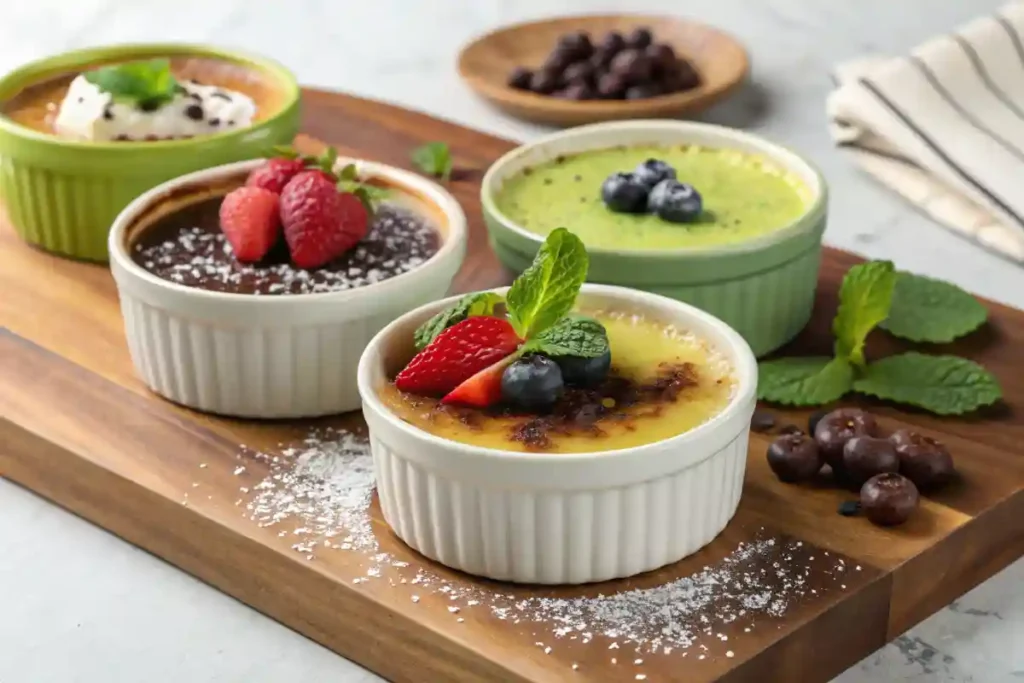
Beyond the Classic: Flavor Variations of Crème Brûlée
While the classic vanilla crème brûlée is timeless, there’s plenty of room to experiment with flavors and variations. Once you master the basic techniques, you can start exploring different flavor profiles to create a crème brûlée that suits your taste. These variations will bring new dimensions to the dessert, allowing you to enjoy it in many ways. Let’s see some ideas for taking your crème brûlée to a new level.
Exploring Flavor Infusions
One great way to elevate your crème brûlée is to infuse the cream with different flavors. For a more intense vanilla flavor, you can use a whole vanilla bean, split lengthwise, and steep it in the cream while it’s being heated. For a floral note, you can infuse it with lavender buds. For citrusy notes, you can use the zest of lemons or oranges, but make sure to strain them before mixing the cream with the egg yolks. You can also make a coffee-flavored crème brûlée by steeping coffee beans in the cream. The possibilities are indeed endless. Be creative, and experiment with your favorite flavors. These flavor infusions will add complexity and a unique touch to your crème brûlée.
Chocolate Crème Brûlée
Another great variation is chocolate crème brûlée. You can achieve this variation by adding chocolate to the custard base. You can use unsweetened cocoa powder for a deep chocolate flavor, or you can melt some dark chocolate and mix it with the cream mixture. Alternatively, you can add chocolate chips to the custard for a more decadent result. Remember to adjust the amount of sugar you add to balance the sweetness of the chocolate. The great thing about chocolate crème brûlée is that the slight bitterness of the chocolate pairs beautifully with the sweetness of the caramel top. It’s a fantastic option if you are a chocolate lover, and it’s a great way to enjoy a classic dessert with a twist.
Answering Your Queries: Crème Brûlée FAQs
Still have some questions about making crème brûlée? Don’t worry, you’re not alone. Here are quick answers to some frequently asked questions, to help clear things up and ensure success.
Why is my crème brûlée grainy?
A grainy crème brûlée usually means the egg proteins overcooked. This often happens from too high heat or baking too long. Keep an eye on the baking time and temperature.
Can I make crème brûlée without a torch?
Yes, you can use your oven’s broiler as an alternative. But watch closely; it can caramelize quickly.
How long does crème brûlée last in the fridge?
Once baked and cooled, crème brûlée will last up to 2-3 days in the refrigerator, covered, but the top might soften.
Can I use milk instead of heavy cream?
You can, but it will be much less rich and creamy. Heavy cream is really what gives the texture we all know and love.
What is the best sugar for the topping?
Granulated sugar is best for caramelizing. It melts and caramelizes evenly. Avoid powdered or coarse sugars.
What is the proper way to store my ramekins?
Make sure your ramekins are completely cooled before storing. Cover them with plastic wrap to maintain freshness.
Conclusion
The Joy of Mastering Crème Brûlée
You’ve reached the end of our journey into the world of crème brûlée! By now, you should have a thorough understanding of what is the secret to crème brûlée. You’ve learned about the science of the custard, the art of caramelization, and the essential techniques needed to create this classic dessert flawlessly. Making crème brûlée is not just about following a recipe; it’s about understanding the why behind each step. And you’ve done it! You’re now well-equipped to create a truly memorable crème brûlée.
Final Thoughts and Encouragement
Remember that every great baker started somewhere. Don’t be discouraged if your first attempt isn’t perfect. The key is to keep practicing, and to learn from your mistakes. Experiment with different flavor infusions, try different sugars for the top, and find what you like most. Mastering crème brûlée is a journey, and the joy is in the process as much as the result. Keep exploring, keep creating, and most importantly, keep enjoying this wonderful dessert! The History of Crème Brûlée.

